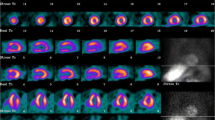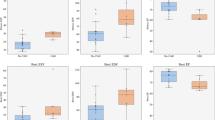Abstract
Background
The ability of stress radionuclide myocardial perfusion imaging to predict adverse cardiac events is well accepted. As left ventricular systolic function has also been shown to be an important prognostic indicator, the objective of this study was to determine whether electrocardiography (ECG)-gated single photon emission computed tomography (SPECT) functional data add additional power.
Methods and Results
In this study 3207 patients who underwent stress myocardial perfusion imaging with ECG gating, without early (<60 days) revascularization, were studied. Subsequent nonfatal myocardial infarction and cardiac death were related to perfusion and ECG-gated SPECT ventricular function parameters. Cox proportional hazards regression analysis was used to evaluate the independent predictive value of these parameters, as well as their added utility over clinical and ECG parameters. Patients with abnormal perfusion images had an annual event rate of 5.1% compared with 1.6% for patients with normal images (P <.001). An abnormal gated SPECT wall motion score was associated with an annual event rate of 6.1% compared with 1.6% for a normal score (P <.001), and an abnormal left ventricular ejection fraction was associated with an event rate of 7.4% compared with 1.8% for normal patients (P <.001). Abnormal ECG-gated SPECT results worsened outcome in both patients with normal perfusion images and those with abnormal perfusion images. Cardiac death was predicted by the number of territories with a perfusion defect and an abnormal ejection fraction, whereas myocardial infarction was predicted by the number of territories with a perfusion defect but not by ejection fraction.
Conclusions
Ventricular function data from ECG-gated SPECT add important prognostic value to data obtained from perfusion imaging alone in predicting adverse cardiac events.
Similar content being viewed by others
References
Bonow ROMyocardial viability. Curr Probl Cardiol 1996;21:150–221.
Gioia G, Milan E, Giubbini R, et al. Prognostic value of tomographic rest-redistribution thallium 201 imaging in medically treated patients with coronary artery disease and left ventricular dysfunction. J Nucl Cardiol 1996;3:150–6.
DiCarli MF, Davidson M, Littel R, et al. Value of metabolic imaging with positron emission tomography for evaluating prognosis in patients with coronary artery disease and left ventricular dysfunction. Am J Cardiol 1994;73:527–33.
Brown KA. Prognostic value of thallium-201 myocardial perfusion imaging. Circulation 1991;83:363–81.
Berman DS, Hayes SW, Shaw LJ, Germano G. Recent advances in myocardial perfusion imaging. Curr Probl Cardiol 2001;26:1–140.
DePuey EG, Rozanski A. Using gated technetium-99m sestamibi SPECT to characterize fixed myocardial defects as infarct or artifact. J Nucl Med 1995;36:952-5.
Taillefer R, DePuey EG, Udelson JE, et al. Comparative diagnostic accuracy of Tl-201 and Tc-99m sestamibi SPECT imaging (perfusion and ECG-gated SPECT) in detecting coronary artery disease in women. J Am Coll Cardiol 1997;29:29:69–77.
Smanio PEP, Watson DD, Segalla DL, et al. Value of gating of technetium-99m sestamibi single-photon emission computed tomographic imaging. J Am Coll Cardiol 1997;30:1687–92.
Lima RSL, Watson DD, Goode AR, et al. Incremental value of combined perfusion and function over perfusion alone by gated SPECT myocardial perfusion imaging for detection of severe three-vessel coronary artery disease. J Am Coll Cardiol 2003;42:64–70.
Sharir T, Germano G, Kavanagh PB, et al. Incremental prognostic value of post-stress left ventricular ejection fraction and volume by gated myocardial perfusion single photon emission computed tomography. Circulation 1999;100:1035–42.
Sharir T, Germano G, Kang X, et al. Prediction of myocardial infarction versus cardiac death by gated myocardial perfusion SPECT: risk stratification by the amount of stress-induced ischemia and the poststress ejection fraction. J Nucl Med 2001;42:831-7.
Staniloff HM, Forrester JS, Berman DS, Swan HJC. Prediction of death, myocardial infarction, and worsening chest pain using thallium scintigraphy and exercise electrocardiography. J Nucl Med 1986;27:1842-8.
Ellestad MH, Wan MK. Predictive implications of stress testing: follow-up of 2700 subjects after maximum treadmill stress testing. Circulation 1975;51:363-9.
Cerqueira MD, Verani MS, Schwaiger M, Heo J, Iskandrian AS.Safety profile of adenosine stress perfusion imaging: results from the Adenoscan Multicenter Trial Registry. J Am Coll Cardiol 1994;23:384-9.
Elhendy A, Bax JJ, Poldermans D. Dobutamine stress myocardial perfusion imaging in coronary artery disease. J Nucl Med 2002; 43:1634–46.
Ranhosky A, Kempthorne-Rawson J. The safety of intravenous dipyridamole thallium myocardial perfusion imaging. Circulation 1990;81:1205-9.
Giri S, Shaw LJ, Murthy DR, et al. Impact of diabetes on the risk stratification using stress single-photon emission computed tomography myocardial perfusion imaging in patients with symptoms suggestive of coronary artery disease. Circulation 2002;105:32–40.
Imaging guidelines for nuclear cardiology procedures, part 2.American Society of Nuclear Cardiology. J Nucl Cardiol 1999;6:G47–84.
Cerqueira MD, Weissman NJ, Dilsizian V, et al, American Heart Association Writing Group on Myocardial Segmentation and Registration for Cardiac Imaging. Standardized myocardial segmentation and nomenclature for tomographic imaging of the heart:a statement for healthcare professional from the cardiac imaging committee of the council on clinical cardiology of the American Heart Association. J Nucl Cardiol 2002;9:240-5.
Hachamovitch R, Berman DS, Shaw LJ, et al. Incremental prognostic value of myocardial perfusion single photon emission computed tomography for the prediction of cardiac death. Differential stratification for risk of cardiac death and myocardial infarction. Circulation 1998;97:535–43.
McClellan JR, Travin MI, Herman SD, et al. Prognostic importance of scintigraphic left ventricular cavity dilation during intravenous dipyridamole technetium-99m sestamibi myocardial tomographic imaging in predicting coronary events. Am J Cardiol 1997;79:600-5.
Germano G, Kiat H, Kavanagh PB, et al. Automatic quantification of ejection fraction from gated myocardial perfusion SPECT. J Nucl Med 1995;36:2138–47.
Hachamovitch R, Berman DS, Kiat H, et al. Effective risk stratification using exercise myocardial perfusion SPECT in women: gender-related differences in prognostic nuclear testing. J Am Coll Cardiol 1996;28:34–44.
Travin MI, Boucher CA, Newell JB, et al. Variables associated with a poor prognosis in patients with an ischemic thallium-201 exercise test. Am Heart J 1993;125:335–44.
Nallamouthu N, Araujo L, Russell J, Heo J, Iskandrian AE.Prognostic value of simultaneous perfusion and function assessment using technetium-99m sestamibi. Am J Cardiol 1996;78:562-4.
Hashimoto J, Suzuki T, Nakahara T, Kosuda S, Kubo A. Preoperative risk stratification using stress myocardial perfusion scintigraphy with electrocardiographic gating. J Nucl Med 2003;44:385–90.
Spinelli L, Petretta M, Acampa W, et al. Prognostic value of combined assessment of regional left ventricular function and myocardial perfusion by dobutamine and rest gated SPECT in patients with uncomplicated acute myocardial infarction. J Nucl Med 2003;44:1023-9.
Johnson LL, Verdesca SA, Aude WY, et al. Postischemic stunning can affect left ventricular ejection fraction and regional wall motion on post-stress gated sestamibi tomograms. J Am Coll Cardiol 1997;30:1641-8.
Emmett L, Iwanochko RM, Freeman MR, et al. Reversible regional wall motion abnormalities on exercise technetium-99mgated cardiac single photon emission computed tomography predict high-grade angiographic stenosis. J Am Coll Cardiol 2002;39:991-8.
Shah PK. Plaque size, vessel size and plaque vulnerability: bigger may not be better. J Am Coll Cardiol 1998;32:663-4.
O’Keefe JH, Conn RD, Lavie CJ, Bateman TM. The new paradigm for coronary artery disease: altering risk factors, atherosclerotic plaques, and clinical prognosis. Mayo Clin Proc 1996;71:957–65.
Rihal CS, Raco DL, Gersh BJ, Yusuf S. Indications for coronary artery bypass surgery and percutaneous coronary intervention in chronic stable angina. Review of the evidence and methodological considerations. Circulation 2003;108:2439–45.
Kang X, Berman DS, Lewin HC, et al. Incremental prognostic value of myocardial perfusion single photon emission computed tomography in patients with diabetes mellitus. Am Heart J 1999;138:1025–32.
Berman DS, Kang X, Hayes SW, et al. Adenosine myocardial perfusion single-photon emission computed tomography in women compared with men. J Am Coll Cardiol 2003;41:1125–33.
Wackers FJT, Young LH, Inzucchi SE, Chyun DA, Davey JA, forthe DIAD investigators. Detection of ischemia in symptomatic diabetics: preliminary results of the DIAD study [abstract]. J Am Coll Cardiol 2003;41:409A.
Calnon DA, McGrath PD, Doss AL, et al. Prognostic value of dobutamine stress technetium-99m sestamibi single-photon emission computed tomography myocardial perfusion imaging: stratification of a high risk population. J Am Coll Cardiol 2001;38:1511-7.
Hachamovitch R, Hayes SW, Friedman JD, Cohen I, Berman DS.Comparison of the short-term survival benefit associated with revascularization compared with medical therapy in patients with no prior coronary artery disease undergoing stress myocardial perfusion single photon emission computed tomography. Circulation 2003;107:2900-6.
Author information
Authors and Affiliations
Corresponding author
Additional information
Supported in part by Bristol-Myers Squibb Medical Imaging, Inc, North Billerica, Mass, and a grant from the Hartford Hospital Research Administration, Hartford, Conn.
Rights and permissions
About this article
Cite this article
Travin, M.I., Heller, G.V., Johnson, L.L. et al. The prognostic value of ECG-gated SPECT imaging in patients undergoing stress Tc-99m sestamibi myocardial perfusion imaging. J Nucl Cardiol 11, 253–262 (2004). https://doi.org/10.1016/j.nuclcard.2004.02.005
Received:
Accepted:
Issue Date:
DOI: https://doi.org/10.1016/j.nuclcard.2004.02.005




